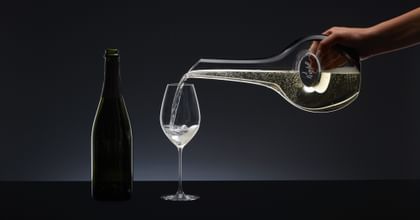World of Wine
Champagne Isn’t Just Bubbles: Decode Champagne Types

Love Champagne but unsure which type suits your taste? You're not alone. With so many Champagne types—brut, rosé, vintage, and even grower Champagne—it can feel overwhelming to choose the right bottle. This guide breaks down the different types of Champagne, so you can sip with confidence and explore styles that elevate every occasion.
Champagne vs. Sparkling Wine
What Sets Them Apart?
All Champagne is sparkling wine—but not all sparkling wine is Champagne. The difference lies in origin, production method, and prestige. To be called “Champagne,” the wine must hail from France’s famed Champagne region and follow the méthode traditionnelle, a meticulous process that lends complexity, elegance, and finesse.
But Champagne isn’t alone in the sparkling world. Italy’s Prosecco is known for its crisp fruit and gentle bubbles, made using the Charmat method, which preserves its bright, youthful character. Spain’s Cava shares Champagne’s traditional method but offers its own profile—dry, structured, with toasty notes and regional charm.
Germany’s Sekt, often underappreciated, ranges from light and floral to rich and refined, depending on whether it's made from Riesling or Pinot varietals, and whether it follows the traditional or tank method.
From Tasmania to California, winemakers are creating exceptional sparkling wines that reflect their terroir. Each style has its own voice, but when it comes to heritage, craft, and celebratory sparkle, Champagne continues to set the gold standard.
The Grapes Behind Champagne Types
Unlike single-varietal wines like Riesling or Shiraz, most Champagne is a blend of three iconic grape varieties—each playing a distinct role in shaping style and character:
- Pinot Noir – Lends structure, depth, and complexity
- Pinot Meunier – Adds vibrant fruit and floral aromatics
- Chardonnay – Brings freshness, elegance, and finesse
Some producers may include lesser-known grapes such as Pinot Blanc or Petit Meslier, but these are rare and often used in tiny quantities.
These grapes form the foundation of different Champagne types:
- Blanc de Blancs: Made entirely from Chardonnay, this style is prized for its bright acidity and citrus-driven purity.
- Blanc de Noirs: Crafted from Pinot Noir and/or Pinot Meunier, these wines are fuller-bodied with generous fruit and a creamy texture.

Rosé Champagne
A Style That Blends Beauty and Depth
Rosé Champagne is one of the most alluring Champagne types—celebrated not just for its blush color, but for its expressive character and versatility. There are two elegant methods used to achieve that signature pink hue:
- Blending: A small portion of still red wine—usually Pinot Noir—is added to the blend for gentle color and subtle red fruit notes.
- Saignée: French for “bleeding,” this method involves a brief maceration with grape skins, adding deeper color, body, and complexity.
Whether pale salmon or rich rose gold, Rosé Champagne elevates every moment—from a refined aperitif to a romantic dessert pairing.
Vintage vs Non-Vintage
Champagne Types Defined by Time
Non-Vintage Champagne (NV) is the most common style—an artful blend of wines from multiple years, designed to maintain a house’s signature taste year after year. If the label doesn’t list a year, it’s likely NV: reliable, balanced, and beautifully suited to any occasion.
Vintage Champagne comes from a single standout harvest, only declared in exceptional years. These bottles are aged for a minimum of three years, developing layered complexity, elegance, and aging potential. When opening a Vintage Champagne, elevate the moment with a RIEDEL Decanter—all expertly designed to reveal its full aromatic depth.
Brut and Beyond
Understanding Champagne Sweetness Levels
Here’s a quick guide to the main styles:
- Brut Nature / Zero: 0–3g/L – bone dry and razor-sharp
- Extra Brut: 0–6g/L – crisp with a whisper of softness
- Brut: 0–12g/L – the classic, dry style favored by many
- Extra Dry: 12–20g/L – slightly sweeter than Brut, despite the name
- Sec, Demi-Sec & Doux: Increasingly sweet, perfect for dessert pairings
Grower Champagne
The Boutique Expression of Terroir
Among the different types of Champagne, Grower Champagne stands out for its authenticity and sense of place. Unlike the major houses that blend grapes from across the region, grower-producers—often called “farmer fizz”—craft their wines from estate-grown fruit, capturing the nuance of a specific vineyard or village.
These Champagnes offer a more intimate, terroir-driven experience. For those seeking character and individuality in every sip, look for the RM (Récoltant Manipulant) label—a mark of true craftsmanship.
Champagne Codes
A Guide to Who’s Behind the Bottle
Beyond Champagne types and styles, the label itself can reveal who made the wine—and how. These abbreviations offer insight into the wine’s origin and production:
- NM (Négociant Manipulant): Large houses blending grapes from various growers
- RM (Récoltant Manipulant): Grower Champagne made by those who farm their own vines
- CM (Coopérative Manipulant): Wines from grower cooperatives under a shared brand
- SR (Société de Récoltants): Independent growers sharing resources but marketing their own names
- RC (Récoltant Coopérateur): Estate-grown wines made using cooperative facilities
- ND (Négociant Distributeur): Wines labeled and sold by a distributor, not the producer
- MA (Marque d’Acheteur): Private-label bottles for retailers or restaurants
Decoding these markings unlocks another layer of Champagne appreciation—whether you’re seeking the timeless consistency of a grande marque or the singular voice of a boutique grower.
Elevate Every Sip with the Right Glass
With a deeper understanding of Champagne types—from Brut to Rosé, Vintage to Grower—you’re ready to toast with confidence. And to truly savor the nuance of each style, pair it with the perfect RIEDEL Champagne glass. Because every great Champagne deserves to be seen, savored, and celebrated in the glass it was made for.
Shop our RIEDEL Champagne glass collection and find your perfect match.
Locations

